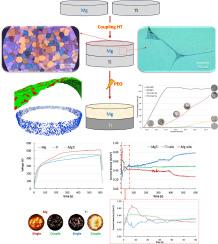当前位置:
X-MOL 学术
›
J. Magnes. Alloys
›
论文详情
Our official English website, www.x-mol.net, welcomes your
feedback! (Note: you will need to create a separate account there.)
Mg-Ti hybrid joints: Surface modification, corrosion studies and 3D-pore investigation using synchrotron-based microtomography
Journal of Magnesium and Alloys ( IF 15.8 ) Pub Date : 2024-09-07 , DOI: 10.1016/j.jma.2024.08.014 M. Fazel, V.M. Garamus, M. Serdechnova, Fabian Wilde, F. Wieland, E. Nidadavolu, T. Wu, T. Ebel, C. Blawert, R. Willumeit-Römer, M.L. Zheludkevich
Journal of Magnesium and Alloys ( IF 15.8 ) Pub Date : 2024-09-07 , DOI: 10.1016/j.jma.2024.08.014 M. Fazel, V.M. Garamus, M. Serdechnova, Fabian Wilde, F. Wieland, E. Nidadavolu, T. Wu, T. Ebel, C. Blawert, R. Willumeit-Römer, M.L. Zheludkevich

|
A new direction toward the future of orthopedic implants is to combine biodegradable Mg alloys with permanent Ti to produce selectively biodegradable hybrid joints for advanced tissue engineering. However, the strong galvanic corrosion between Mg and Ti is a major issue to be considered. This work aims to explore plasma electrolytic oxidation (PEO) as a single-step coating treatment to allow for an acceptable degradation behavior of MgTi hybrid systems. To this end, MgTi hybrid joints were produced through the heat treatment of Mg-0.6Ca and commercially pure Ti specimens at 640 °C for 8 h. A single-step PEO treatment was then employed to create a protective layer on the surface of hybrid couples. Even though the scanning electron microscopy (SEM) images showed only a porosity of 6% and 12% within the PEO layers on single Mg and MgTi couples, 3D investigation of the synchrotron-based microtomography data demonstrated a porosity of 18% and 30% with a considerable number of interconnected pores. According to the electrochemical impedance spectroscopy measurements, the impedance modulus at all frequencies on coated MgTi coupled specimens was lower than that on the coated single Mg-0.6Ca and pure Ti. However, the application of PEO treatment significantly decreased the strong galvanic degradation of Mg-0.6Ca in contact with Ti. The results of hydrogen evolution tests revealed that PEO-treated MgTi couples showed a similar degradation behavior as the single alloy during the first day of immersion.
中文翻译:

镁钛混合接头:使用基于同步加速器的显微断层扫描进行表面改性、腐蚀研究和 3D 孔隙研究
骨科植入物未来的一个新方向是将可生物降解的镁合金与永久钛结合起来,生产用于先进组织工程的选择性可生物降解的混合关节。然而,Mg和Ti之间的强电偶腐蚀是一个需要考虑的主要问题。这项工作旨在探索等离子体电解氧化 (PEO) 作为一种单步涂层处理方法,以实现 MgTi 混合系统可接受的降解行为。为此,通过对 Mg-0.6Ca 和商业纯 Ti 样品在 640 °C 下热处理 8 小时来生产 MgTi 混合接头。然后采用单步 PEO 处理在混合对的表面形成保护层。尽管扫描电子显微镜 (SEM) 图像显示单个 Mg 和 MgTi 对的 PEO 层内的孔隙率仅为 6% 和 12%,但基于同步加速器的显微断层扫描数据的 3D 研究表明,孔隙率分别为 18% 和 30%大量相互连通的孔隙。根据电化学阻抗谱测量,涂层 MgTi 耦合样品在所有频率下的阻抗模量均低于涂层单一 Mg-0.6Ca 和纯 Ti。然而,PEO处理的应用显着降低了Mg-0.6Ca与Ti接触时的强烈电偶降解。析氢测试的结果表明,经过 PEO 处理的 MgTi 对在浸泡的第一天表现出与单一合金相似的降解行为。
更新日期:2024-09-07
中文翻译:

镁钛混合接头:使用基于同步加速器的显微断层扫描进行表面改性、腐蚀研究和 3D 孔隙研究
骨科植入物未来的一个新方向是将可生物降解的镁合金与永久钛结合起来,生产用于先进组织工程的选择性可生物降解的混合关节。然而,Mg和Ti之间的强电偶腐蚀是一个需要考虑的主要问题。这项工作旨在探索等离子体电解氧化 (PEO) 作为一种单步涂层处理方法,以实现 MgTi 混合系统可接受的降解行为。为此,通过对 Mg-0.6Ca 和商业纯 Ti 样品在 640 °C 下热处理 8 小时来生产 MgTi 混合接头。然后采用单步 PEO 处理在混合对的表面形成保护层。尽管扫描电子显微镜 (SEM) 图像显示单个 Mg 和 MgTi 对的 PEO 层内的孔隙率仅为 6% 和 12%,但基于同步加速器的显微断层扫描数据的 3D 研究表明,孔隙率分别为 18% 和 30%大量相互连通的孔隙。根据电化学阻抗谱测量,涂层 MgTi 耦合样品在所有频率下的阻抗模量均低于涂层单一 Mg-0.6Ca 和纯 Ti。然而,PEO处理的应用显着降低了Mg-0.6Ca与Ti接触时的强烈电偶降解。析氢测试的结果表明,经过 PEO 处理的 MgTi 对在浸泡的第一天表现出与单一合金相似的降解行为。


















































 京公网安备 11010802027423号
京公网安备 11010802027423号